The Gwinn Aircar
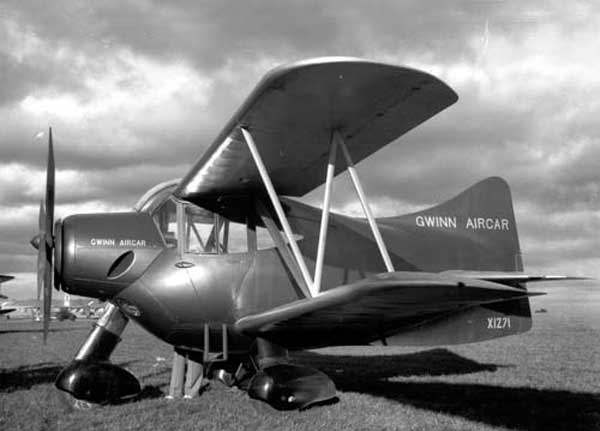
The Gwinn Roadable Airplane was a safe airplane, easy to operate and as cheap to buy as the average automobile. This was the American dream in the air-minded 1930s.It all began when Joseph Marr Gwinn Jr., a World War I aviator and engineer at Consolidated Aircraft Corporation, chose to remain in Buffalo, N.Y., after the company moved to San Diego, Calif.
He had designed what he deemed was a safe, roadable airplane after two years of dedicated research and development, and in 1935 he organized the Gwinn Aircar Company Inc. in Buffalo, serving as the new firm's president and chief engineer. Two years later, the prototype Gwinn Aircar was completed and test-flown by Richard K. Bennett, who also gave well-known aviator Frank Hawks the chance to test the new plane. After Hawks flew the Aircar in Buffalo, he was so enthusiastic about its performance that he agreed to become Gwinn Aircar's vice president in charge of sales.
The Gwinn Aircar Company of Buffalo, NY was formed in 1935 by Joseph M Gwinn, Jr, former Chief Engineer at Consolidated Aircraft Corporation. The 'Aircar' was designed as a 'foolproof' airplane that would be simple and, above all, safe to fly since it would neither stall nor spin. The aircraft first flew in early 1937 and received Civil Aeronautics Authority Approved Type Certificate 682. Gwinn hired Frank Hawks, racing pilot and record setter, and Nancy (Harkness) Love, another famous pilot, to tour the country demonstrating the aircraft. On 23 August 1938, Hawk failed to clear high tension power lines while taking off in the Aircar and was killed in the resulting crash. Gwinn suspended production and closed the Aircar plant.
Gwinn Aircar
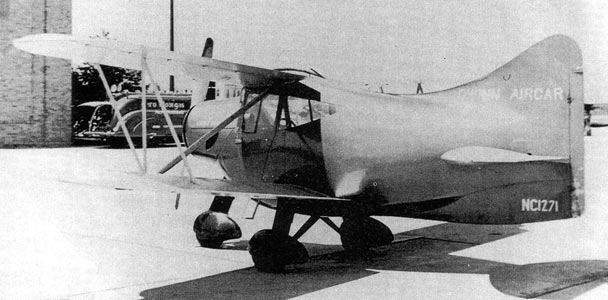
A biplane configuration with an 18 percent thickness airfoil was
selected to keep the wingspan to a maximum 24 feet. A tricycle
landing gear was selected for good roadable visibility, and a
wooden four-bladed, 1,600-rpm propeller was chosen to reduce noise.
In addition, a special muffler was fitted with a long engine exhaust
pipe that extended over the cabin, terminating just aft of the
upper wing. The 90-hp British Pobjoy Niagara II radial engine
proved to be somewhat underpowered for the 1,600-pound plane,
but plans were underway to construct a130-hp Pobjoy Niagara V-7-powered
version.
In order to help inexperienced pilots with coordinating the ailerons and rudder during a turn, the cabin control wheel was the only directional and pitch control device. Push-pull for nose up or down and turning the wheel operated both ailerons and elevators for directional control. The control wheel also operated the nose wheel for steering on the road and had to be manually reconnected from ailerons and elevators to the nose wheel and return as required from outside the cabin.
Flying the Aircar was very simple.
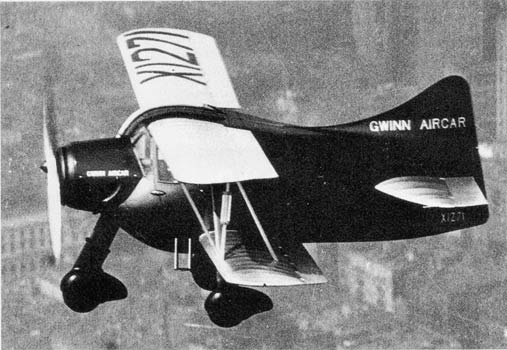 When takeoff speed was reached, the pilot pushed the left-side
floor pedal to the floor, lowering the flaps to takeoff position.
Takeoff was immediate, and the stall-proof Aircar merely zoomed
on takeoff if the elevator wheel was inadvertently pulled all
the way back.
When takeoff speed was reached, the pilot pushed the left-side
floor pedal to the floor, lowering the flaps to takeoff position.
Takeoff was immediate, and the stall-proof Aircar merely zoomed
on takeoff if the elevator wheel was inadvertently pulled all
the way back.
The Aircar would then automatically enter a normal flight attitude. Landing was also simple. With the engine idling, the pilot merely leveled the Aircar and guided the plane to the runway Engine speed when flying was controlled via a conventional instrument-panel knob. On the road, the pilot used a floor pedal similar to that in a conventional automobile. Conversion from panel knob to floor pedal was done manually outside the cabin.
Converting from wheel to propeller drive and return could not
be accomplished from inside the cabin, as this change required
reconnecting the engine from the propeller gearbox to the road
wheels gearbox. The road wheels were driven via a hydraulic system
that required no gear changes by the driver.
The Aircar's fuselage was an all-metal monocoque structure of aluminum formers with alloy skin. Seven subassemblies were bolted together to comprise the fuselage. The wings were constructed in four panels, with solid spruce spars and stamped aluminum ribs. The leading edges were covered with sheet aluminum, while the entire wing was fabric covered. A rigid diagonal strut was installed instead of the conventional landing and flying wires, facilitating alignment when removing and replacing the wing panels. The vehicle's wings consisted of four 31/2-by-10-foot panels that were bolted to fittings on the fuselage. Each panel could be carried by two men and conveniently stored in a hangar, garage or shed.
The Fin Was Integral To The Fuselage.
The stabilizer
was an airfoil-shaped structure of aluminum, while the elevator
frame was constructed of steel tubing. Both were fabric covered.
The pilot and passenger sat side by side on a bench seat. All
the amenities expected in an automobile were provided in the Gwinn
Aircar: cabin vents, heater, glove compartment, ashtrays, sun
visors, tool compartment and first aid kit. Radio and paraflares
were optional. Operating accessories included an electric engine
starter, battery, generator, oil cooler, navigation lights, landing
lights and wheel brakes. Two automobile-type doors with automobile
handles made the Aircar seem familiar to customers comfortable
with cars rather than airplanes. The control wheel swiveled upward
to make it easy to get in and out of the cabin.
Power could be supplied to the wheels when the vehicle was used on the road. This required disconnecting the propeller gear box, and hooking up the hydraulic system that supplied power to the wheels. Perhaps it was a cumbersome way to make the change, but for its time it was a remarkable achievement. Gwinn hired two pilots, Frank Hawks and Nancy Love, to tour the country demonstrating the aircraft.
Tragedy struck on August 23, 1938, in East Aurora, N.Y. Frank Hawks had completed a demonstration flight in the second of two Aircars built, No. NC 16921, and was taking off with a prospective client when he failed to clear high-tension wires at the end of the field. The Aircar struck the wires and burst into flames, killing the pilot and his passenger. The resulting publicity effectively spelled the end for the Aircar. Joseph Gwinn closed his factory and faded into obscurity. The other plane, NC 1271, was still flying in Dearborn, Mich., in 1945, but its subsequent fate is unclear.
The Aircar's demise did not put an end to the idea of the roadable airplane. During the late 1940s and early '50s several other airplane-auto combination designs appeared. Despite considerable media coverage, however, they received a lukewarm reception and failed to catch on.
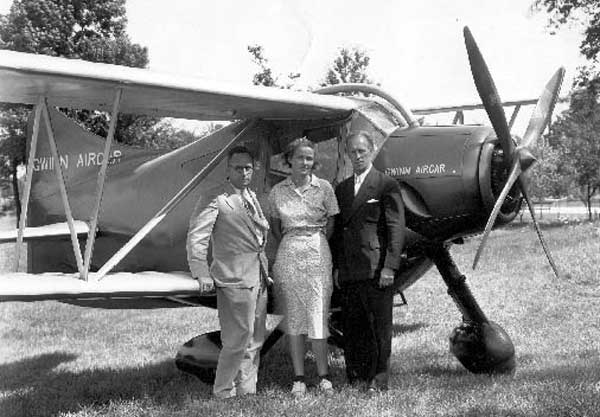
Joseph Gwinn, Nancy Harkness and Frank Hawks, ca. 1937-38
Specifications
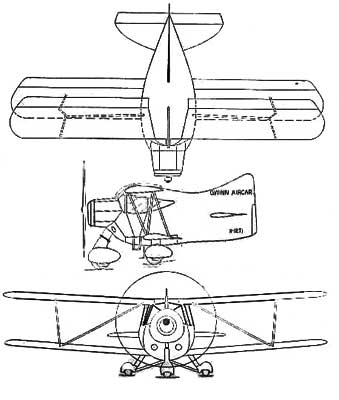 |
Wing area: 169.4 square feet Performance |
 |
 |
Frank Hawks Dies In Crash, Aug 1938 -- With Hawks flying against a crosswind, Rogers recounted what happened next to news reporters: "The plane lifted in the air and Hawks tilted it 50 feet above the ground to enable it to pass between two tall trees. As he passed out of sight it looked as though he had not been able to gain sufficient altitude and was trying to bring the plane down." The plane's wheels dangled into telephone and power lines, caught fire, and was hurtled, nose-over-tail, to the ground on the polo field of Seymour Knox, an internationally known polo player, and Campbell's brother-in-law, where it exploded. Onlookers pulled Hawks from the controls of the blazing ship and dragged Campbell from beneath a crumpled and burning wing, but the broken telephone wires forced the delay of hospital aid.
Three hours later, at the hospital in Buffalo, Frank Hawks died. Campbell also died of the injuries he sustained in the crash. |

